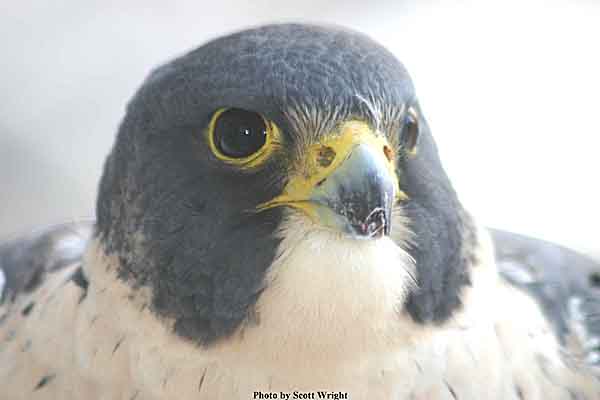FALCON FLASH
Dateline: Cleveland, Ohio
April 16, 2013
Click here to read what happened earlier
As you monitor the FalconCam, you may notice that the parents sit on the eggs with their backs arched as in the following picture. Sara Jean Peters, Ohio Division of Wildlife (retired), tells us: "Note the way feathers are fluffed here...it's a great way to allow heat to escape. Young birds are doing a lot of exercises in a very small room as they break open their shell. It's easy for them to overheat, so the parents are trying to keep them warm....but not too warm."
SW and Boomer’s eggs will be hatching soon. This year, the fourth egg was laid on March 21st, and incubation usually lasts 33 to 35 days from the date the last egg, or the second last, was laid. When do you think the first egg will hatch? Keep in mind, however, this year was unusual because there was a delay between the laying of the second and third eggs. Right now you can look for signs that point towards hatching. You may notice that the parents seem to be listening to their eggs. Are the little chicks peeping inside?
In the last few days before the hatch, the female often does not want to leave the nest and chases the male away if he offers to take over incubation. In the following picture, SW is taking a quick break, and you can see the 2 brood patches on her breast that keep the egg temperature just right during incubation. A brood patch is a patch of skin without feathers that birds have during nesting season. Direct contact with the skin helps birds to transfer heat to their eggs when incubating and to the chicks after they hatch.
As SW waits, take a close look at her beak.It's hard to see on the FalconCam, but you can look for tiny cracks on an egg that is about to hatch and then a "pip", which is a small hole that the young bird inside the egg has made with its special egg tooth. According to Mr. Harvey Webster, Director of Wildlife Resources at the Cleveland Museum of Natural History, “It generally takes 24-36 hours between the onset of the pip and actual hatching. The parents do not assist in the hatching process”. Volunteer nest monitor Mr. Scott Wright, adds: "Look for an eggshell, but do it quick as the female will often eat the eggshell, and move the shell about, often picking it up with her beak. Yes, eggs can hatch out during the night. Hairline cracks will indicate that a hatch is under way".
As SW waits, take a close look at her beak.
The eggs will be hatching soon, so keep your eyes and browser set on:
Our thanks to the Cleveland Museum of Natural History for sponsoring the FalconCams.
Photos of SW and Boomer listening and the close-ups of SW’s face are courtesy of Scott Wright. Photos of SW fluffed up over the eggs and of SW’s brood patches are courtesy of Mr. and Mrs. Saladin. The video of SW incubating the eggs is courtesy of Mr. and Mrs. Saladin. They may be used in any non-commercial publication, electronic or print, but please give photo credit.
Volunteer nest monitors, Mr. and Mrs. Saladin, tell us some interesting facts about beaks: “Peregrines have the v-shaped notch in the beak that severs the spine of prey with a bite to the back of the neck. They also have nostrils that deflect and/or draw in airflow during a stoop or fast flight-- this allows peregrines to dive at high rates of speed that would knock out a fighter pilot by balancing the oxygen to the brain. Their cere (the yellowish to orangeish skin above the beak) is said to vary in color according to not only the subspecies influence but also the variation in the peregrine's diet. Males are said to typically have more of an orangeish hue compared to a female's more yellowish hue of the cere”. Seven years ago, SW had an accident and broke her beak. It happened in winter before nesting season.
Dr. Patrick T. Redig, Professor and Director of the Raptor Center at the University of Minnesota College of Veterinary Medicine, reassured worried falcon fans saying, “I expect she'll be okay - should be completely regrown in about 2 - 3 months …… her mate will feed her.” He was right, and SW’s beak grew back good as new. She went on to lay eggs and raise chicks successfully that spring and ever since. The fact that her mate took care of her while she could not hunt is an illustration of how falcon couples cooperate to sustain each other, their families and the species.
To watch a video of SW incubating the eggs go to:
Click here to read what happened next





